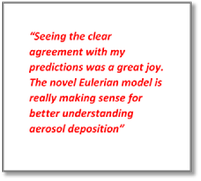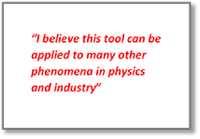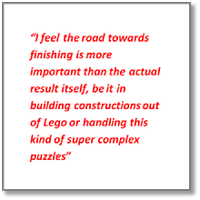 This thesis deals with aerosols: small particles or droplets in gases. In his PhD work Edo Frederix aimed at modeling aerosol dynamics, distinguishing between aerosol evolution and aerosol transport.
This thesis deals with aerosols: small particles or droplets in gases. In his PhD work Edo Frederix aimed at modeling aerosol dynamics, distinguishing between aerosol evolution and aerosol transport.
Droplet nucleation, condensation/evaporation and coagulation/break up, were central topics in the first part. ‘Especially when gases are cooling down rapidly, lots of droplets form,’ he says. ‘To give an estimate: up to 1010 can appear in a short notice of time within only one cm3. One can imagine modeling individual trajectories would need ages of computer time.’
To capture the dominant mechanisms by mathematical models, Edo worked on a novel suitable Eulerian framework. ‘A key feature is that it is sectional: a collection of droplet number concentrations corresponding to unique representative droplet sizes are modeled,’ Edo explains. ‘By doing so, we could account for poly-dispersisty plus treat the particulate state from a continuous point of view altogether.’
The complexity of the model was significantly reduced this way, leading to valuable predictions in a computational feasible way. A second important feature of the Eulerian framework is that the model is internally mixed: the droplets chemical composition is allowed to be locally independent of the droplet size.

The Eulerian model was embedded inside the so-called compressible PISO algorithm: Pressure Implicit with Splitting of Operator. Doing so, time-accurate solutions to a set of coupled transport equations could be found.
A consistent method could be derived to capture aerosol droplet drift for example. ‘Aerosol aspiration’ could be accounted for, and good agreement was found with experimental data. Edo: ‘This is a mechanism in which aerosol concentrations locally increase, due to an additional influx of drifting droplets at a specific region.’
Collaboration
During his work Edo had close collaboration contacts with Philip Morris, being the main financial contributor to this PhD work. ‘Nowadays they are open about their interest in these phenomena which are of prime importance in their tobacco products,’ Edo says. ‘We phoned on a regular basis, sharing our programming codes and data. The interest and expertise shared was special. Also we collaborated with the Nuclear Research Group in Petten.’
Agreement with experiments

As a special moment in his PhD project, Edo recalls the good agreement experimental results from a 3D cast of the upper human airways, had with his Eulerian modeling approach. ‘The geometry of the human lung is really complex,’ he says. ‘Seeing the clear agreement with my predictions was a great joy. The novel Eulerian model is really making sense for better understanding aerosol deposition. Therefore I believe this tool can be applied to many other phenomena in physics and industry.’

Validating, implementing and simulating was a vast portion of his work. ‘The details of this work are minute and require lots of concentration, to really rule out any mistakes. Already from childhood on, I like to totally focus on one main task. I feel the road towards finishing is more important than the actual result itself, be it in building constructions out of Lego or handling this kind of super complex puzzles.’
Critical distance
Edo: ‘All in all the PhD progressed in a steady manner, leading to some good results. I learned to put my goals in a broader context while working on the project, looking from a critical distance towards the final goals I really want to achieve, instead of searching for quick answers running towards the computer in too early a phase. This approach leads to more profound results, I am sure of. It also helps me to report my results systematically in publications, as the research is embedded within a broader plan. After my Defense I will finish some publications and start some new topics in a post-doc position at our group. After that I prefer to go and work in an R&D job in industry, working on challenging ideas to create new solutions, I hope.’
